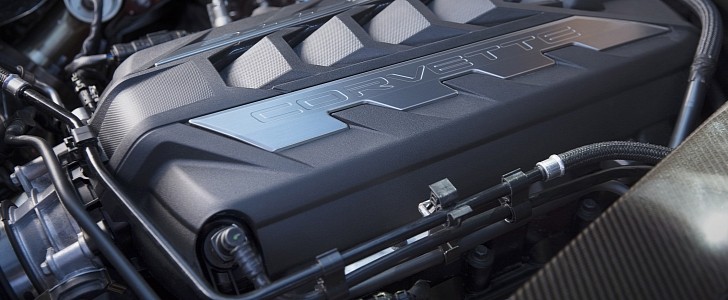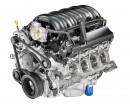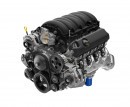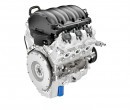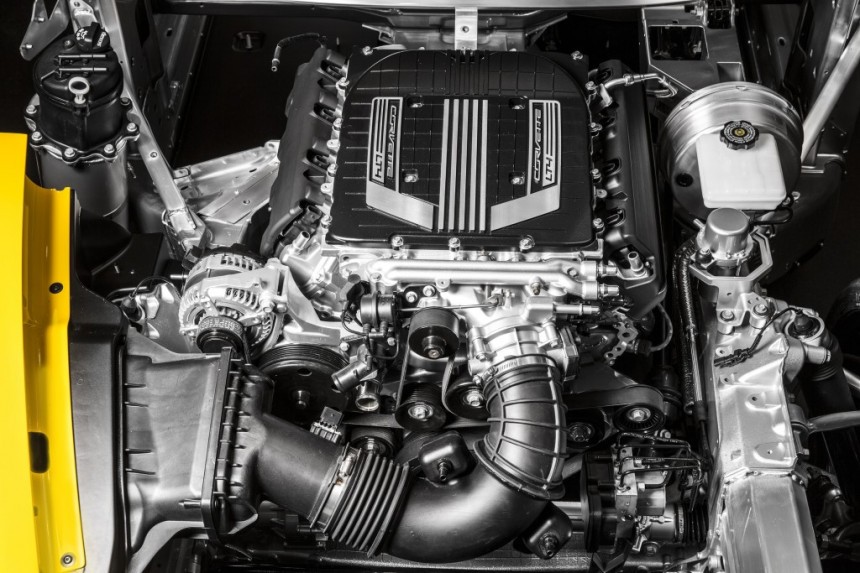GM introduced the small-block V8 engine architecture in the mid 1950s. Continuously improved over the next four decades, the biggest of the Big Three in Detroit had to replace the venerable powerplant in the late ‘90s.
The LS family of engines may follow a similar recipe to the original small block from the Golden Bowtie, yet it’s considered a clean-sheet motor in many aspects. Like, a lot! From the six-bolt layout to the relocated spark plugs, better flow of the heads, larger camshaft, steam vents, and plastic intake that suffers from less heat soak, these changes aren’t only skin deep.
Early in the 2000s, there was hearsay according to which General Motors had a few upgrades in store for the LS. The fourth-gen small block launched in 2004 with a focus on displacement on demand, better known as Active Fuel Management in the automaker’s jargon. Variable valve timing needs to be highlighted as well because it offers better performance and fuel economy.
Then rumored to premiere in the seventh-generation Chevrolet Corvette sports car, the fifth-generation small block is called LT as a tribute to the LT-1 from the ‘70s and LT1 350 from the ‘90s. Rather confusingly, the Chevrolet Corvette Stingray’s powerplant for the 2014 model year is also called LT1.
Heavily related to the LS3, this fellow boasts direct fuel injection, revised cylinder heads, better cooling, and valves that are flipped from the LS. Continuously variable valve timing, a variable displacement oil pump, and piston cooling jets pretty much sum up the LT family, along with a rather controversial fuel-saving technology that we’ll cover later on.
The 6.2-liter engine is SAE-certified 460 horsepower and 465 pound-feet (630 Nm) of torque from 4,600 revolutions per minute with the performance-oriented exhaust system, which is plenty enough for such a light vehicle. It’s also easier on the dinosaur juice than its predecessor, with the Environmental Protection Agency rating it at 21 miles to the gallon (11.2 liters per 100 kilometers) on the combined testing cycle.
The LT1 further sweetens the deal with available dry-sump oiling, a camshaft-driven fuel pump for the DI System, and the runners-in-a-box intake manifold that allows for high-efficiency airflow packaged beneath the Corvette’s hood line. Based on the design of the previous-generation LS7, the four-into-one exhaust manifolds are necessary to mention as well.
Also for the 2014 model year, General Motors launched the L83 and L86 truck engines that were developed into the L84 and L87. The primary difference between the L83/L86 and L84/L87 is Dynamic Fuel Management, which is capable of alternating between 17 firing orders to save fuel whenever possible. As opposed to the four-cylinder AFM, DFM is capable of running in two-cylinder mode, which seems to be overkill in light-duty workhorses and utility vehicles such as the Silverado and Suburban.
The LT4 was introduced for the 2015 model year in the Corvette Z06, then shoehorned under the hood of the 2017 model year Camaro ZL1. Loosely inspired by the LS9 from the sixth-generation Corvette ZR1, this lump is an LT1 with a thumpin’ great supercharger on top. The Roots-type blower is shared with the LT4 in the 2022 model year Cadillac CT5-V Blackwing, which pumps out 668 horsepower and 659 pound-feet (893 Nm) of torque.
General Motors followed suit with the LT5 in the supercar-shaming C7 Corvette ZR1, which is topped with a 2.6-liter Eaton TVS supercharging system and a beefier intercooler. The LT5 also combines direct injection with port injection, marking the first dual-injection system offered by the Big G.
The iron-block L8T sports a larger stroke than every other LT we’ve covered so far, translating to 400 cubic inches or 6.6 liters of displacement. Developed for heavy-duty truck applications, this engine makes over 11 percent more horsepower and 21 percent more torque compared to the previous gas engine for large trucks. Interestingly enough, the L8T doesn’t flaunt Active Fuel Management, Dynamic Fuel Management, or start-stop.
As for the latest and most radical member of the LT family, the mid-engine Corvette Stingray features the all-aluminum LT2 with dry-sump lubrication. Moving the powerplant from the front to the middle of the car translates to redesigned exhaust manifolds, relocated coil packs, a different layout for the accessory drive, and a rearward-facing throttle body. Of course, GM has also modified the intake system to a significant degree. The intake plenum, for example, displaces 14.1 liters instead of the LT1’s 11.1 liters.
Even the exhaust valve lift has been increased by 1 millimeter to improve the exhaust valve flow rate from 122 to 125 grams per second. The flywheel had to shrink because the engine sits so close to the ground, and finally, the torque-converter automatic of the seventh-generation Corvette Stingray had to be swapped for a dual-clutch automatic transmission supplied by Tremec.
Although it’s not a V8, we couldn’t end this guide without mentioning the LV3. Often described as an LT1 with the two rearmost cylinders loped off, the 4.3-liter V6 is a stout engine, developing 285 horsepower and 305 pound-feet (414 Nm) of torque in the Silverado. Just like the 5.3- and 6.2-liter V8s described earlier, the LV3 is marketed under the EcoTec3 moniker.
Looking forward, the 2023 model year will bring forth the LT6 in the Corvette Z06, a flat-plane crankshaft V8 that makes in the ballpark of 600 horsepower.
Early in the 2000s, there was hearsay according to which General Motors had a few upgrades in store for the LS. The fourth-gen small block launched in 2004 with a focus on displacement on demand, better known as Active Fuel Management in the automaker’s jargon. Variable valve timing needs to be highlighted as well because it offers better performance and fuel economy.
Then rumored to premiere in the seventh-generation Chevrolet Corvette sports car, the fifth-generation small block is called LT as a tribute to the LT-1 from the ‘70s and LT1 350 from the ‘90s. Rather confusingly, the Chevrolet Corvette Stingray’s powerplant for the 2014 model year is also called LT1.
Heavily related to the LS3, this fellow boasts direct fuel injection, revised cylinder heads, better cooling, and valves that are flipped from the LS. Continuously variable valve timing, a variable displacement oil pump, and piston cooling jets pretty much sum up the LT family, along with a rather controversial fuel-saving technology that we’ll cover later on.
The 6.2-liter engine is SAE-certified 460 horsepower and 465 pound-feet (630 Nm) of torque from 4,600 revolutions per minute with the performance-oriented exhaust system, which is plenty enough for such a light vehicle. It’s also easier on the dinosaur juice than its predecessor, with the Environmental Protection Agency rating it at 21 miles to the gallon (11.2 liters per 100 kilometers) on the combined testing cycle.
The LT1 further sweetens the deal with available dry-sump oiling, a camshaft-driven fuel pump for the DI System, and the runners-in-a-box intake manifold that allows for high-efficiency airflow packaged beneath the Corvette’s hood line. Based on the design of the previous-generation LS7, the four-into-one exhaust manifolds are necessary to mention as well.
Also for the 2014 model year, General Motors launched the L83 and L86 truck engines that were developed into the L84 and L87. The primary difference between the L83/L86 and L84/L87 is Dynamic Fuel Management, which is capable of alternating between 17 firing orders to save fuel whenever possible. As opposed to the four-cylinder AFM, DFM is capable of running in two-cylinder mode, which seems to be overkill in light-duty workhorses and utility vehicles such as the Silverado and Suburban.
General Motors followed suit with the LT5 in the supercar-shaming C7 Corvette ZR1, which is topped with a 2.6-liter Eaton TVS supercharging system and a beefier intercooler. The LT5 also combines direct injection with port injection, marking the first dual-injection system offered by the Big G.
The iron-block L8T sports a larger stroke than every other LT we’ve covered so far, translating to 400 cubic inches or 6.6 liters of displacement. Developed for heavy-duty truck applications, this engine makes over 11 percent more horsepower and 21 percent more torque compared to the previous gas engine for large trucks. Interestingly enough, the L8T doesn’t flaunt Active Fuel Management, Dynamic Fuel Management, or start-stop.
As for the latest and most radical member of the LT family, the mid-engine Corvette Stingray features the all-aluminum LT2 with dry-sump lubrication. Moving the powerplant from the front to the middle of the car translates to redesigned exhaust manifolds, relocated coil packs, a different layout for the accessory drive, and a rearward-facing throttle body. Of course, GM has also modified the intake system to a significant degree. The intake plenum, for example, displaces 14.1 liters instead of the LT1’s 11.1 liters.
Even the exhaust valve lift has been increased by 1 millimeter to improve the exhaust valve flow rate from 122 to 125 grams per second. The flywheel had to shrink because the engine sits so close to the ground, and finally, the torque-converter automatic of the seventh-generation Corvette Stingray had to be swapped for a dual-clutch automatic transmission supplied by Tremec.
Although it’s not a V8, we couldn’t end this guide without mentioning the LV3. Often described as an LT1 with the two rearmost cylinders loped off, the 4.3-liter V6 is a stout engine, developing 285 horsepower and 305 pound-feet (414 Nm) of torque in the Silverado. Just like the 5.3- and 6.2-liter V8s described earlier, the LV3 is marketed under the EcoTec3 moniker.
Looking forward, the 2023 model year will bring forth the LT6 in the Corvette Z06, a flat-plane crankshaft V8 that makes in the ballpark of 600 horsepower.
